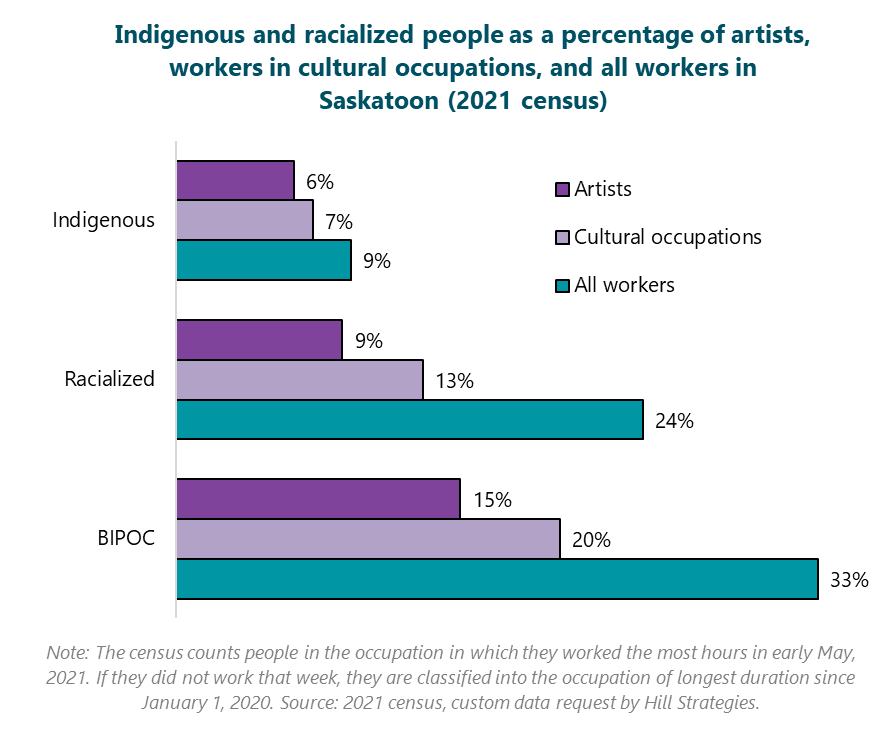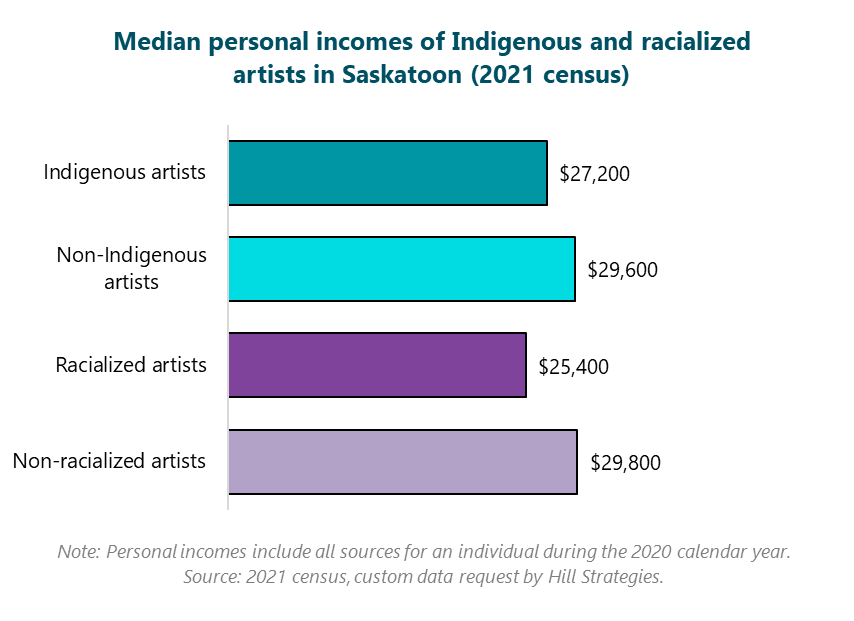Saskatoon’s Indigenous and racialized artists and cultural workers: A statistical profile
Indigenous and racialized people are less represented among the city’s artists and cultural workers and tend to have lower incomes than non-Indigenous and non-racialized workers
This article highlights statistics on Indigenous and racialized artists and cultural workers in the City of Saskatoon, using custom data that Hill Strategies requested from Statistics Canada’s 2021 long-form census.
The article was prepared at the request of the City of Saskatoon. Hill Strategies retained analytical independence and editorial control of the content.
In the census, Indigenous identity is based on self-identification as First Nations, Métis, and/or Inuit. In this article, I generally use the term racialized to refer to what Statistics Canada has called the visible minority population. For brevity, the article sometimes uses the acronym BIPOC (black, Indigenous, people of colour) to refer to the entirety of Indigenous and racialized workers in the city.
Details of the census questions and other notes regarding methods are provided at the end of this article.
Number of Indigenous and racialized workers in the arts, culture, and heritage in Saskatoon
BIPOC artists
The 1,390 artists in Saskatoon represent 0.9% of the 153,100 people in the city’s overall labour force.
Among the 1,390 artists in Saskatoon, 210 are BIPOC (15% of the city’s artists), including 90 Indigenous artists (6%) and 120 racialized artists (9%). No Saskatoon artists or cultural workers indicated that they are both Indigenous and racialized.
BIPOC cultural workers
There are 5,700 workers in arts, culture, and heritage occupations in Saskatoon, representing 3.7% of the city’s labour force.
Of the 5,700 cultural workers, 1,140 are BIPOC (20% of the city’s cultural workers), including 410 Indigenous cultural workers (7%) and 730 racialized cultural workers (13%).
Representation of BIPOC people is lower in the arts, culture, and heritage than in the overall workforce
The following graph compares the proportion of artists, all cultural workers, and all workers in Saskatoon who are Indigenous or racialized.
Whether they are Indigenous or racialized, the representation of BIPOC workers is highest in the city’s overall workforce, followed by the broad cultural workforce, with lower representation of BIPOC people as artists.
For example, all Indigenous individuals represent 9% of the city’s labour force, 7% of workers in cultural occupations, and 6% of artists. All racialized people represent 24% of the city’s labour force, 13% of workers in cultural occupations, and 9% of artists.
Incomes of BIPOC artists and cultural workers in Saskatoon
The financial analysis in this article focuses on median incomes, which are believed to provide a better indication of the situation of a typical professional artist than the average (i.e., the “mean”), which is more strongly affected by a few individuals with very high incomes. The article examines income statistics for artists as a group and for cultural workers as a group – not for individual occupation categories (e.g., writers, actors, performing arts managers, etc.).
Median personal income was chosen as the key indicator, as it includes all sources of an individual’s income. It should be kept in mind that the income statistics from the 2021 census relate to the 2020 calendar year, which included significant slowdowns in artistic activity.
Incomes of BIPOC artists
Whether they are Indigenous or racialized, the median incomes of BIPOC artists are lower than for other artists in Saskatoon, as shown in the following graph.
The median personal income of Indigenous artists (from all sources) was $27,200 in 2020, 13% lower than the median for non-Indigenous artists ($29,600).
The median personal income of Saskatoon’s racialized artists was $25,400 in 2020, 20% lower than the median for non-Indigenous artists ($29,800).
Incomes of BIPOC cultural workers
Among cultural workers in Saskatoon, Indigenous Peoples have a very similar median income to non-Indigenous workers ($42,800 vs. $43,200, as shown at the top of the next graph).
The statistics are very different for racialized cultural workers, for whom the median income ($32,800) is 27% lower than for non-racialized cultural workers ($45,200).
Notes on census methods
The analysis relates to professional workers, but with a very specific concept of professional. Census data on occupations include people who worked more hours as an artist than at any other occupation between May 1 and 8, 2021, plus people who were not in the labour force at that time but had worked more as an artist than at another occupation between January of 2020 and May of 2021. Part-time artists who spent more time at another occupation in May of 2021 would be classified in the other occupation. (The same would be true of workers in all cultural occupations.)
The occupational perspective counts people who work across the economy, as long as they are classified into one of 10 artist occupation groups or 52 cultural occupation groups. Details about the occupation groups included in these categories is available in a recent article, which also outlined the methods behind choosing the 52 cultural occupation groups. Another article highlighted some strengths and limitations of the census for counting artists and cultural workers. To ensure confidentiality and data reliability, no estimates of fewer than 40 people are presented in this article.
Statistics Canada indicates that, in the census, “Indigenous identity refers to whether the person identified with the Indigenous peoples of Canada. This includes those who identify as First Nations (North American Indian), Métis and/or Inuk (Inuit), and/or those who report being Registered or Treaty Indians (that is, registered under the Indian Act of Canada), and/or those who have membership in a First Nation or Indian band.”
There is a great diversity of Indigenous Peoples residing on the territory commonly known as Canada. However, for the purposes of this focus on artists – a relatively small population group – it has been necessary to examine Indigenous Peoples as one group.
Readers should be aware that Census data are less complete for Indigenous Peoples than many other groups, which might result in a low estimate of the number of Indigenous artists, cultural workers, and other workers. However, this may be less of an issue in urban areas than on reserves. Some reserves and settlements did not allow census activity within their borders, while other areas were inaccessible due to wildfires or floods in the spring of 2021. Statistics Canada estimates that 23% of the on-reserve Indigenous population did not respond to the long-form census, a non-response rate that is almost 10 times higher than in the general population (2.6%). The response rate was likely higher for Indigenous residents off-reserve than on-reserve.
According to Canada’s Employment Equity Act, visible minority people include “persons, other than Aboriginal peoples, who are non-Caucasian in race or non-white in colour." Census respondents, including members of their household, were classified as racialized or not mainly based on their response to the question “Is this person:”, followed by 11 response options containing the most common population groups as well as an area for a brief open-ended response. The 11 readily available options were: White, South Asian (e.g., East Indian, Pakistani, Sri Lankan), Chinese, Black, Filipino, Arab, Latin American, Southeast Asian (e.g., Vietnamese, Cambodian, Laotian, Thai), West Asian (e.g., Iranian, Afghan), Korean, and Japanese. Respondents could select multiple options for each person in their household. Respondents selecting any option except for White were counted as racialized people, as were some respondents who wrote in their response.
The challenging context of the pandemic in the spring of 2021 is important to keep in mind when interpreting census data on artists, which were collected in May of 2021. Income data from the census relate to the 2020 calendar year.






